To continue planting fruits and vegetables outside of the production seasons or to boost growth in winter, the 17 million gardeners in the UK can resort to the horticultural lamp. This device provides plants with the light and warmth they need. But which one should you choose from the wide range of products on the market? Save time in your research by relying on our guide.
Here is our commitment, to make sure that we provide the best user experience and content quality:
You can support us by using our links to make your purchases (at no extra cost to you)! This sometimes earns us a commission which allows us to remain independent. More about us
Our selection
"This is the most powerful of the Niello horticultural lamps. Designed for a growing area of 3.5 m², it is suitable for both flowering and…"
"This horticultural lamp will meet the nutrient, light and heat needs of your plants as they grow. It has a wide spectrum of 9 bands…"
"The Spider Farmer SF-2000 combines low power consumption and large growing area. The life span of its 608 full spectrum LED bulbs can reach 100,000…"
"This horticultural lamp is for demanding gardeners. But beware of blue light. Staying too long in the vicinity of the Garpsen Cree COB can have…"

This is the most powerful of the Niello horticultural lamps. Designed for a growing area of 3.5 m², it is suitable for both flowering and growing. And, its height covers 1,3 x 1,2 m.
173 £ on AmazonThe Niello 1000W horticultural lamp is characterized by a low power consumption of 400 W. The efficiency of the light spread is ensured by a 90° optical lens, suitable for all plants. Crops are improved thanks to its full 12-band spectrum. It is effective at all stages of growth.
Good to know, you can choose between the VEG and BLOOM switch to adapt the use to the expected result. Equipped with silent fans, this horticultural lamp offers a comfort of use adapted to the beginners and can be used for a long time, more precisely up to 18 h without interruption.
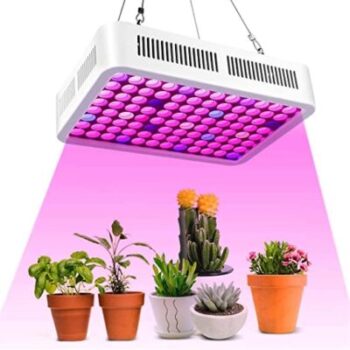
This horticultural lamp will meet the nutrient, light and heat needs of your plants as they grow. It has a wide spectrum of 9 bands and a successful heat dissipation system.
63,99 £ on AmazonRoleadro 600W generates a wide spectrum of 9 bands (450-470nm blue, 610-740nm red, and 410nm purple, 2700K yellow and 6500K white), including infrared and ultraviolet. This LED grow light can improve the nutrient supply during the growth of flowers and vegetables like orchids, roses, lettuce, tomatoes, cucumbers, broccoli, etc.
The powerful light of Roleadro 600W LED is well assimilated by plants, thus promoting their yield. Apart from that, the heat dissipation of the Roleadro lamp is done by 2 fans. Note that the LEDs that make up the lamp have a life span of 50,000 hours.
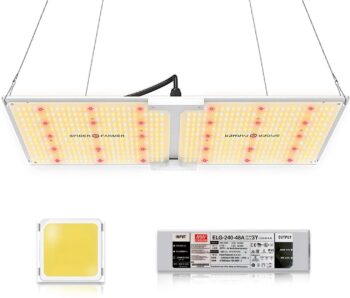
The Spider Farmer SF-2000 combines low power consumption and large growing area. The life span of its 608 full spectrum LED bulbs can reach 100,000 hours!
312 £ on AmazonThe Spider Farmer SF-2000 is a very innovative growth lamp that will undoubtedly please for its solidity, its efficiency and its low operating cost. Indeed, this growth lamp consumes only 100 W while allowing itself a life of 100 000 h. This low consumption is supported by a Meanwell driver, a system particularly appreciated for its reliability.
In its full spectrum are infrared and other colors. The versatility of the Spider Farmer SF-2000 is not negligible to grow various plants: vegetables, flowers and others. Moreover, the intensity of the light can be adjusted according to the needs of what you grow.

This horticultural lamp is for demanding gardeners. But beware of blue light. Staying too long in the vicinity of the Garpsen Cree COB can have a negative impact on your eyesight.
128 £ on AmazonThe Garpsen Cree COB lamp features 1,000W COB chip LEDs and lamp beads with lenses for more efficient and uniform illumination. Scientifically engineered to maintain the ideal balance between coverage and light output, this horticultural lamp delivers full spectrum light from 420-460 nm, 630-660 nm, 730 nm, 3000 K, 3500 K, 5000 K, 6500 K and includes red/blue/UV/IR spectrums.
This range of wavelengths is ideal for the vegetation and flowering stages, meeting the growth needs of your plants. The Garpsen lamp is easy to install. In addition, it comes with a variety of mounting options, including a daisy chain option.
Any specific needs?
The best horticultural lamp in 2021
The best entry-level horticultural lamp
The best high-end horticultural lamp
A horticultural lamp known for its efficiency and stability
Your guide :
Rate this buying guide :By rating this buying guide, you are helping us to reward our best writers. Thank you!
| TOP OF THE LINE | CHEAP | TOP OF THE LINE | EXCELLENT | |

In accordance with our commitment, this buying guide does not contain any sponsored products. |
 8/10 |
 9/10 |
 8/10 |
 7/10 |
| OUR SELECTION |
Niello 1000W
|
Roleadro 600W LED
|
Spider Farmer SF-2000
|
Garpsen Cree COB
|
|
This is the most powerful of the Niello horticultural lamps. Designed for a growing area of 3.5 m², it is suitable for both flowering and growing. And, its height covers 1,3 x 1,2 m.
|
This horticultural lamp will meet the nutrient, light and heat needs of your plants as they grow. It has a wide spectrum of 9 bands and a successful heat dissipation system.
|
The Spider Farmer SF-2000 combines low power consumption and large growing area. The life span of its 608 full spectrum LED bulbs can reach 100,000 hours!
|
This horticultural lamp is for demanding gardeners. But beware of blue light. Staying too long in the vicinity of the Garpsen Cree COB can have a negative impact on your eyesight.
|
|
|
Energy savings
|
|
|
|
|
|
Light source
|
LED
|
LED
|
LED
|
LED
|
|
Light spectrum
|
12 bands
|
9 bands
|
12 bands
|
12 bands
|
|
Power/consumption
|
1,000 W
|
600 W
|
100 W
|
1,000 W
|
|
Color temperature
|
2,700 K, 3,000 K, 4,200 K, 4,500 K
|
2,700 K and 6,500 K
|
3,000 K, 5,000 K
|
3,500 K, 5,000 K and 6,500 K
|
Help us improve this table:
Report an error, request the addition of a feature to the table, or suggest another product. Thank you for your kindness!
We spend thousands of hours each year studying the major specialized websites, analyzing products of hundreds of brands and reading user feedback to advise you on the best products.
We are a product review company with a single mission: to simplify your buying decisions. Our research and testing helps millions of people every year find the best products for their personal needs and budget.
To support us you can: use our links to make your purchases (which often earns us a small commission), share our articles on social networks, or recommend our site on your blog. Thanks in advance for your support!

In addition to light, lamps also generate a certain amount of heat that should be specific. This is a characteristic to be taken into account because some plants require more heat than others. This is the case for example for tropical plants. On the other hand, other houseplants like snow peas or lettuce may require a cool environment. It should be noted that plants should not come in contact with hot bulbs as these may burn and ruin the crop.
Another factor to consider is the light spectrum provided by the bulbs. Without getting too technical, some types of bulbs filter out the lights (in the spectrum) that your plants need. You can find this note on the bulb packaging. A 2700 K (Kelvin) bulb will be a good starting point for flowers, but is not high enough for vegetables. In general, vegetables require 6,500 K.
The higher the temperature, the cooler the light. To promote flowering, choose a color temperature range between 1,500 K and 3,000 K. To benefit photosynthesis during cannabis cultivation, for example, opt for a temperature between 3,000 K and 3,700 K. If you want to boost the growth of your plants quickly, a color temperature between 3,700 K and 4,000 K will be ideal. 4,000 K causes normal growth of cannabis plants while 4,000 K - 5,000 K promotes good growth of leaves and stems. Finally, between 5,000 K and 8,000 K, you will have excellent leaf and stem growth.
HID lights are some of the most efficient grow bulbs because they generate a lot of lumens. Although LED lights are by far the most energy-efficient, HPS bulbs turn the energy they use into light output (85-100 lumens per watt). So opt for these models if you have crops in areas that receive no natural light or if you undertake large operations that require high production.
This area actually depends on the height at which the lamp is installed relative to your crop. The higher the lamp, the harder it is for photons to reach your plant. The manufacturers indicate in their technical data sheet the adequate height to better cover a given surface. Based on these data, you can calculate the number of lamps needed to cover your entire plantation.
Photoperiodic lighting
Low light intensity to regulate the flowering of greenhouse crops
Additional lighting
Moderate light intensity to improve photosynthesis in greenhouse crops
Only one light source
High intensity lighting for better indoor plant growth
General description
Main purpose
To promote flowering
Increase growth, yield and quality attributes
Accurately regulate plant growth and quality attributes
Main target crops
Ornamental plants
Seedlings, berries, vegetables and other high value crops
Green leafy vegetables, herbs, young plants, berries and other high value crops
Use
When the natural photoperiod is less than 13 hours and only at night
When the daily light is low, and only at night and on cloudy days
Every day
Typical intensity (photon flux density)
1-2 µmol.m-2.s-1
60-120 µmol.m-2.s-1
150-200 µmol.m-2.s-1
Spectrum
More or less distant red
Red and blue/white or white
Red and blue/white or white
Number of hours of use per day
Normally up to 4 hours
Normally up to 20 hours
Normally between 18 and 24 hours
Control of the size and shape of the plants (height and size of the leaves)
Light to moderate
Light
Strong
Horticultural lamps differ from each other depending on the type, need and region in which your plantation is located. Here is a closer look at them.
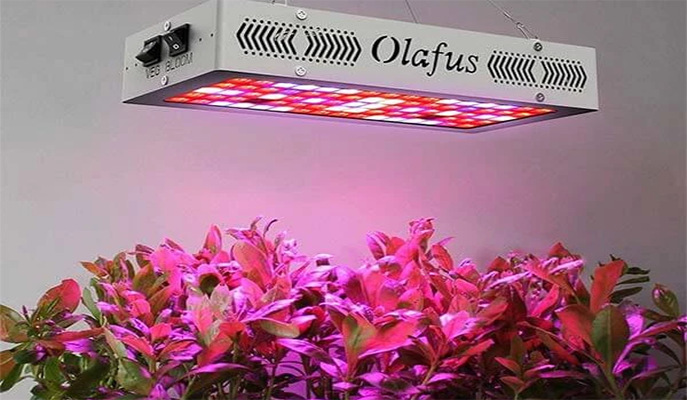
LED light is a new technology that provides extraordinary amounts of light with very little energy. In addition to being relatively inexpensive, it is also quite compact. It is also a durable option. However, since LED lights provide no heat, your plants may freeze if they are installed in a cold garage, shed or basement.
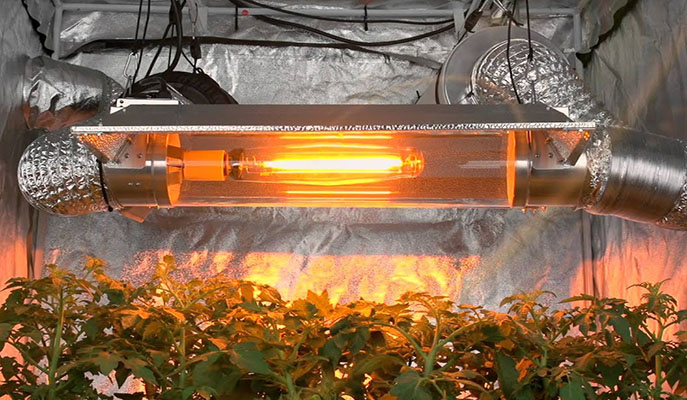
High intensity discharge lamps (HID lamps) are known as the third generation of artificial light source. This category of lamp mainly includes metal halide (MH), high-pressure sodium (HPS), low-pressure sodium and mercury vapor lamps. It offers a high intensity of light and a better heat source.
However, the problem with these lamps is that they require special ballasts to operate. In other words, they cannot be powered by a regular 110V or 240V household electricity source. Plus, because HID lamps produce a lot of heat, they can burn your plants if you're not careful.
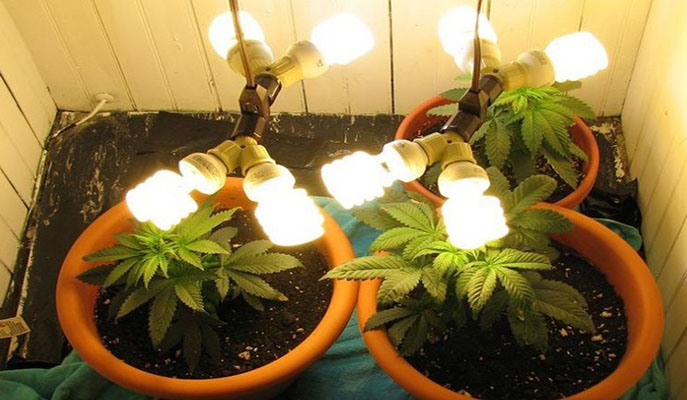
The compact fluorescent lamp (CFL) is considered the second generation of artificial light source. There are three main types of fluorescent lamps: cold cathode, hot cathode and electroluminescent. Fluorescent lamps work by ionizing the mercury vapor in the glass tube. This causes the electrons in the gas to emit photons at UV frequencies.
CFLs are available in different wattages and color temperatures and are less energy intensive. However, they have a low light output and tend to have a shorter life than other types of lamps.
LED (light-emitting diode) lamps are semiconductor designs, which allow electrical energy to pass with low resistance in one direction, and with considerable resistance in the other direction. This movement causes the emission of light, whose color varies depending on the materials used such as phosphide, gallium nitride, aluminum, zinc and silicone. In fact, the new full-spectrum models can offer up to 11 wavelength bands of light that plants need most, ranging from ultraviolet to infrared.
The HPS (high pressure sodium) lamp is in fact a high voltage energy discharge light emission in a pressurized quartz tube filled with sodium vapor as well as other components such as xenon and mercury to achieve whiter lighting. There are now new so-called "full-spectrum" bulbs like the HPS/MH, featuring a 600W HPS arc and a 400W metal halide arc, to give up to 110,000 lumens and a much more accurate representation of daylight than simple HPS lamps.
If you are looking for a light source that offers a wide variety of colors and wavelengths for your planting, choose LEDs, which also consume less energy. However, LEDs are far from being suitable for cold regions as they generate little heat and less light intensity than HPS. In this sense, if the colors or lights that your plants need are in the range generated by the HPS and your crop is likely to freeze, choose the latter which offers more luminous flux but make sure you have the necessary ballast because the HPS are more energy consuming and do not operate at 220V.
At high enough intensities, any type of light from any source can cause eye or skin damage due to prolonged thermal exposure or photochemical effects from ultraviolet, blue light and/or infrared emissions. Shorter wavelength, higher energy blue light (400 and 500 nm) can damage the retina. Higher concentration light sources will provide more direct energy and a higher risk.
Cleaning a horticultural lamp
To clean a removable bulb on a socket, first turn off all power and wait a few minutes for the bulb to cool and then unscrew it. Once the bulb is completely cool, wipe it gently with a cloth soaked in water and a few drops of rubbing alcohol. Also, try to clean the inside of the socket with a dry cloth before permanently putting the bulb back in.
Installing a horticultural lamp
If
your planting is on a shelf, hang your lights on the top and middle one with chains and S-hooks. If your plantation is on the ground, install the lamps above it at the optimal height recommended by the manufacturers. Connect and plug the horticultural lamps to a power strip with a programmable timer and set your timer according to the type of lighting you want to trigger the growth process of your plant. It is also important to incorporate reflective devices into your design when installing the horticultural lamp to minimize light photon losses and optimize the expected output.
Adapted light to give a plant growth boost
As a
general rule, a full-spectrum grow light with a color temperature in the blue range (5,000 - 7,000K) helps promote vegetative growth and a color temperature in the red range (3500 - 4500K) for fruiting and flowering
.
Solution for horticultural lamps that start to make noise
Some
horticultural lamps have a built-in cooling fan that generates some noise. They need to be dusted from time to time to prevent the fan from becoming out of alignment and producing an annoying noise.
Adjusting horticultural lamps with additional features
Some
models of horticultural lamps offer a possibility for you to manually adjust according to your preferences, the right type of light according to the growth stages of your plants. Thus, boost the blue during growth and the red during flowering. Other models also simulate day and night with the help of a programmer to allow the plant to rest before a new lighting cycle.
The best horticultural lamp depends on your needs and budget. Read our buying guide for the best products out there.
You
can use any LED bulb to grow plants if the bulb emits enough light. However, light alone is not enough to stimulate plant growth. You also need enough heat. In fact, plants often seek heat from the light source and unfortunately, LED bulbs don't provide much of it.
Plants live best with light that has lots of red and blue and smaller amounts of green and yellow.
No. On the
other hand, they can suffer because of too much heat energy accompanying the light.
Today,
the most commonly used lamps for professional use are HIDs and fluorescents. Indoor flower and vegetable growers typically use high-pressure sodium (HPS / SON) and metal halide (MH) HID lamps, but fluorescents and LEDs are replacing metal halides because of their efficacy, affordability, and low-energy characteristics.
Every month we help more than 1 000 000 people buy better and smarter.
Copyright © 2022 - Made with ♥ by buyingbetter.co.uk
Your reviews and buying guides 0% advertising, 100% independent!